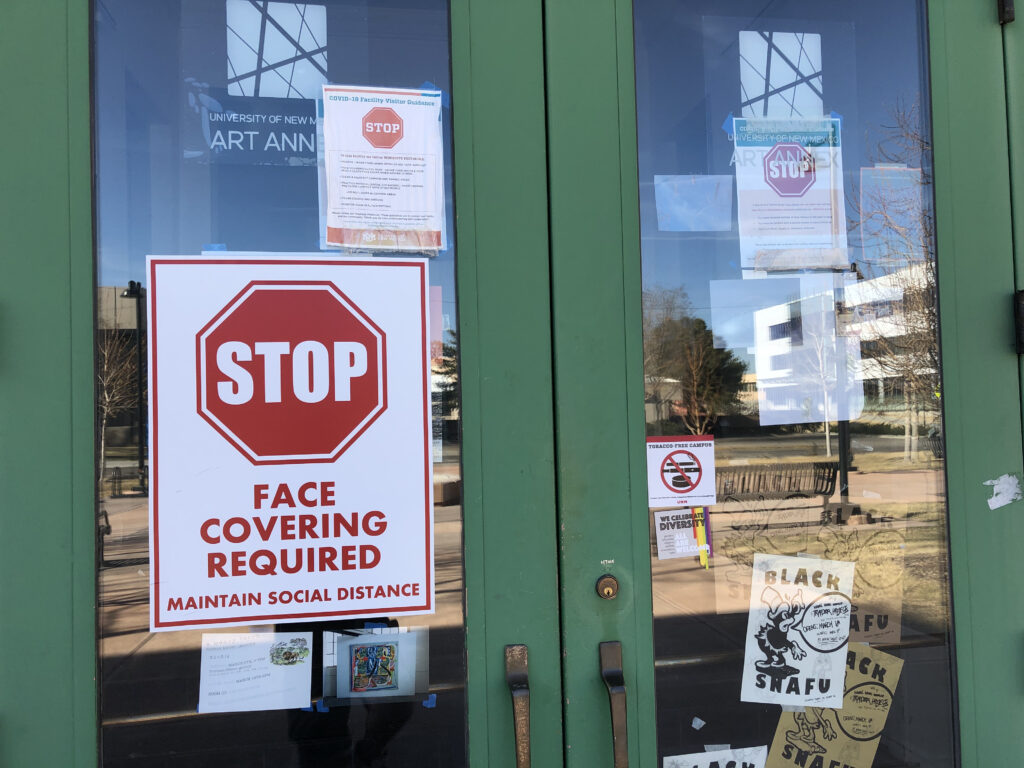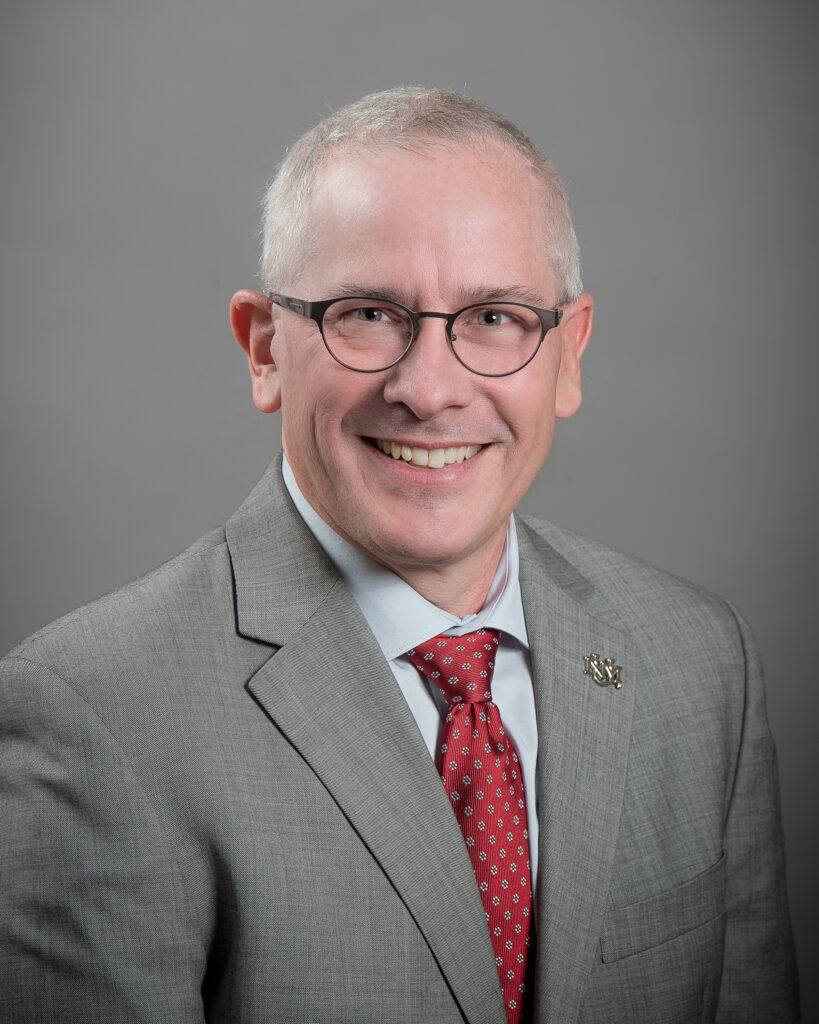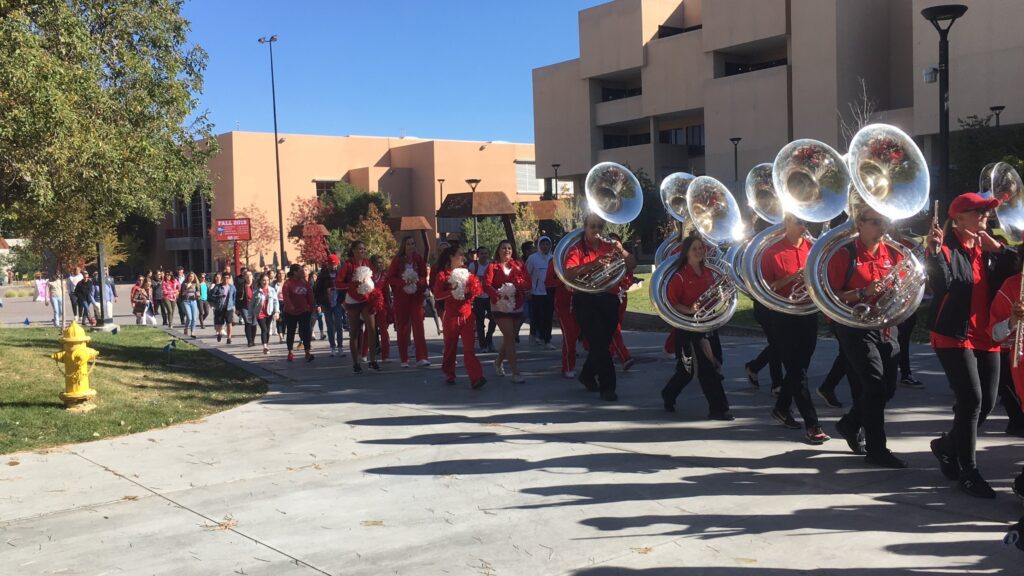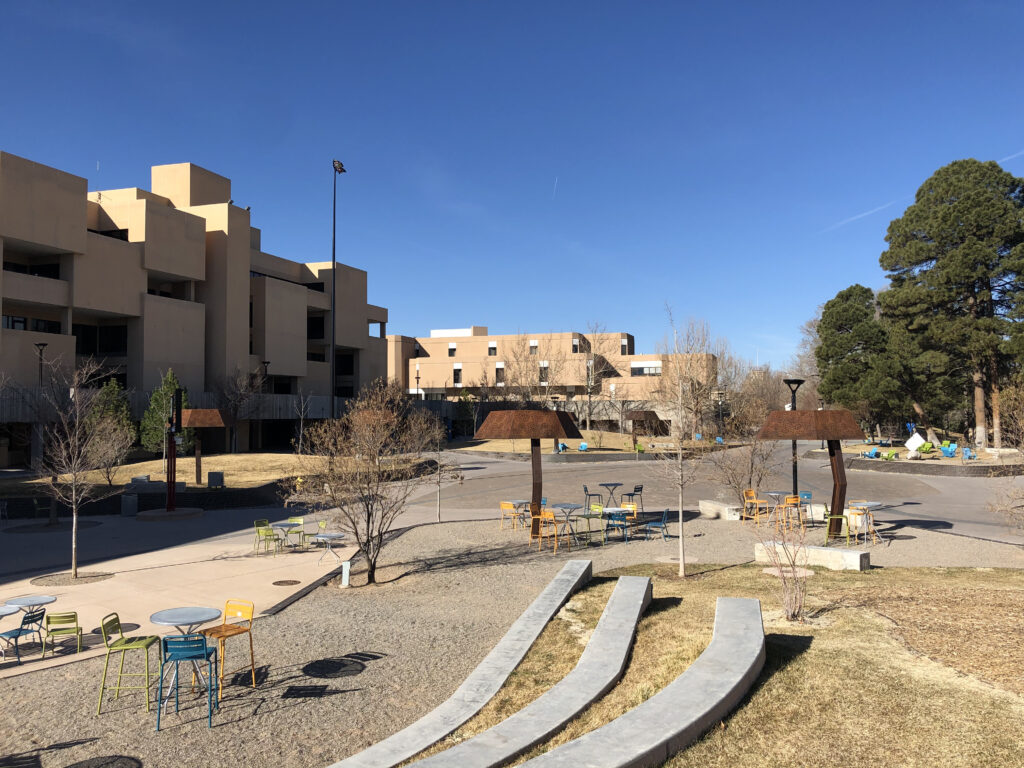By William Jennings / NM News Port
A year ago on this day, the University of New Mexico extended spring break for two weeks to evaluate next steps and see if the suddenly-emerging COVID-19 situation would improve.
It didn’t.
Elexis Panas, then a UNM sophomore, remembers it like yesterday.
“Everything was normal,” Panas said. “And then all of a sudden everything just stopped.”
One year later, tens of thousands of students still haven’t returned to their classrooms and do not anticipate doing so until next fall.
Spring 2020: The UNM community reckons with a once in a century pandemic
While some members of the UNM community were blindsided by the move to online, Panas remembers seeing the shutdown coming.
“I think Arizona was getting a case and then Colorado got cases and so we were kind of boxed in,” Panas said. “I remember every lunch it was like ‘how soon do you think it’s going to be until everything gets shut down?’ It was just constant worry before everything lit up.”
That day came on March 11, 2020, when the governor announced that the first three cases of COVID-19 were detected in New Mexico.
Only two days later, UNM President Garnett Stokes announced the school would be extending spring break by two weeks while leaders figured out how to best continue the semester.
“ I was like, ‘you know what I have a feeling this isn’t going to end well.’ So I took everything, absolutely everything. And then I was glad I did.” -UNM student Elexis Panas
Panas said there was a lot of discussion in her sorority about whether the three-week shutdown would be extended.
“I talked to my roommate and said ‘do you think that we should pack everything?’” Panas said. “For me, I was like, ‘you know what I have a feeling this isn’t going to end well.’ So I took everything, absolutely everything. And then I was glad I did.”
Six days later, on March 19, Stokes announced that UNM was officially shuttered for the semester.
All classes would convert to online only. Previously scheduled online classes began March 23 with all other classes being conducted fully online starting April 6.
Graduation, sports, and all other student activities were canceled.
On the faculty side, the university and faculty union officially negotiated special provisions to ensure they would not be penalized for taking leave because of COVID or because of poor student evaluations.
As for students living on-campus, UNM requested over email that students living on-campus move out. However, they did say that students who could not move out would be allowed to stay.
Lexxus Salazar was a senior last spring living in the Lobo Rainforest dorms and saw the effects of this request firsthand.
“A lot of kids thought they were getting kicked out,” Salazar said. “I knew a lot of people that thought they had no choice and that they had to just figure out some other form of housing. And that’s really stressful, especially mid-semester.”
Salazar said a big part of the confusion was that the details of the move-out were not communicated well enough.
“I think they could have made it more clear that they weren’t kicking people out, they were asking people to leave,” Salazar said.
She also wishes UNM acted faster to ensure the safety of students living on campus.
“They really didn’t have any plan for how to keep students safe in the housing,” said Salazar. “My roommate was flying in from Las Vegas, Nevada. There wasn’t a system in place for her to quarantine at that point, which wasn’t safe for me and also wasn’t safe for anyone else in the building.”
UNM’s Provost, Dr. James Holloway acknowledges that safety measures and communication last spring were lacking but said that was partially fueled by how quickly the guidance was changing from the state government.
“Folks may remember that literally we’d say something in the morning and the state would put out a new directive in the afternoon and what we said in the morning was no longer relevant,” Holloway said.
”It’s been helpful that it’s not just the university that has gotten more clear, but the state and the nation.”
Holloway also noted that ensuring communication reached as much of the UNM community as possible was difficult.
Part of UNM’s attempt to remedy this began in May when the university began having meetings to ensure communication was consistent and thorough.
“One of the things that the university communications office has really done is really helped us ramp up multiple channels of communication,” Holloway said. “There’s been a much more multi-pronged approach to getting messages out.”
As for what happened when classes resumed on April 6, many students, including Salazar and Panas, felt there was a significant drop in quality.
“None of the professors were prepared,” Salazar said. “I finished fine but didn’t learn anything and if you weren’t used to, or able to excel in, an online setting I think that would have been really hard to keep up with.”
Panas said she believes UNM tried to adapt even if it did not live up to her wishes.
“I think they did the best they could with spring,” Panas said. “It really sucked though… It was awful.”
Panas, an engineering major, added that some of her classes seemed to let students through even if they did not know the material.
“The thing is they tried to pass everyone but I think that messed me up because my calc two class just passed me,” Panas said. “For calc three, I wasn’t prepared so I dropped it because I was like, ‘this is too much. I wasn’t ready for this.’”
Fall 2020: Childhood bedrooms becomes classrooms for an entire generation
With the end of the spring semester, UNM took the opportunity to prepare for the first full-length semester in a COVID-19 world.
As part of these preparations, UNM created a dashboard on August 23 to track COVID spread amongst the community.
According to the dashboard, there were 48 cases of the virus amongst students, staff, and faculty between March and August.
By the end of 2020, that number rose to 360 cumulative cases on main campus, which can partially be explained by a national spike in infections but also more thorough testing.
UNM also prepared to reopen in-person learning albeit at greatly reduced capacity with only around 1,000 students being physically on campus any given day during the fall. All other students would work online.
Graduations, sports, and all other student activities remained canceled or were heavily modified for safety.

UNM athletics saw all in-state games canceled with practices initially allowed to continue albeit with new COVID-19 safety measures. However, many practices were still forced to stop and start multiple times due to COVID-19 infections amongst the team.
As COVID-19 cases rose in the fall, even sports practices were canceled and many of UNM’s teams relocated to other states to avoid the strict COVID restrictions in New Mexico.
Other student activities were relegated completely online with organizations such as UNM Resident Life and Student Housing hosting Zoom movie nights and bingo games for students to participate in remotely.
One area where many students, like Panas, said UNM should have done more to help students was locking in the fall course schedule earlier to prevent late class cancellations and capacity changes that put students in a difficult position.
“With COVID I don’t even know if I’m going to graduate on time because our classes right now since most of them require a lab, have been cut down to only 15 people,” Panas said. “Then they all have to be spread out throughout the week. So if you have 30 seniors trying to take that class, you don’t get to graduate.

Holloway said a big reason for the constant changes to the class schedule, was because of how the COVID-19 situation changed by the day.
“We didn’t want to say things and then have to come back later and say, ‘no, no, no, no we changed our minds.’ So that caused us to be fairly cautious about putting out communications before we were rock solid that we could do and deliver whatever it is we were saying,” Holloway said. “You may remember we were making changes to the schedule last August and it was very disruptive for students. It was and we apologize for that.”
Salazar said these issues weren’t the only problem though. She believes UNM faculty didn’t take the time over the summer to prepare for a whole semester of online teaching.
“I wasn’t learning anything,” Salazar said. “I had a professor that didn’t know how to check the online submissions to grade them.”
It is worth noting that UNM did train 748 professors prior to the semester to prepare them for a semester of online teaching. These training programs continued through the fall. However, Salazar said she did not even notice a difference.
“By that fall semester professors still didn’t know how to work the online system,” Salazar said. “I had one that was confused every week on how to open the modules. They would be open by like Tuesday or Wednesday every week and she wouldn’t push out deadlines.”
Panas agrees with this sentiment.
“A lot of older professors were not prepared at all,” Panas said. “I think in fall every teacher was like, ‘okay we’ve done this before; It should be fine’ but it wasn’t fine because they were still learning everything.”
Spring 2021: UNM finds its footing
With the arrival of spring came another chance to fix what went wrong in previous semesters.
In terms of student education, the university continued to train faculty in remote teaching techniques to better meet university learning goals.
Panas, now a junior, said she has noticed a significant increase in the effectiveness of classes. She said a big reason for this was that professors finally seemed to be responding to feedback.

“I think that they’ve actually listened to us because they’ve had so many problems,” Panas said. “My probability class has several forms of communication and…. he reviews every single homework to make sure you understood it. Since we’re not on campus, it’s not like you can just walk on over there and ask him a question.”
Holloway acknowledged the improvements from fall to spring and said the extra time to learn what worked helped them tweak their response for the spring.
“I think the main difference about spring is that we were very confident we could do it,” said Holloway. “For spring, we knew what we could do and we knew what would be appropriate having monitored the COVID cases on campus during the fall term. We knew that what we were doing was working and it was working really well.”
While hybrid education did see a slight dip with 20% of classes this spring having some in-person component compared to 23% in the fall, students are still generally impressed with the changes they have seen.
Panas thinks there is room to improve but admits it is the best semester since UNM was forced online.
“There’s still glitches though. One of my professors forgot to put his headphones on so he could hear us and we had to scream to get his attention,” Panas said. “Still, I think this has actually been the best semester online so far because they had a whole test run of a full semester. I think that is the difference.”
UNM’s cumulative cases of COVID on campus sit at 483 of publication; an increase of only 120 from last year, indicating UNM’s strategies to keep students safe are working.
Still, Panas thinks UNM could do more. She recommends restricting campus to students and enforcing it.
“I was at the duck pond and there were a ton of people… that made me not want to go back because what if they bring COVID,” Panas said. “There is no security that is checking who’s coming on campus right now. So that was the first and last time I was on campus because I was like, ‘there’s a lot of people here. This is probably not safe.’”
Salazar, who has since graduated and now works on campus, said she thinks UNM has done its best to keep people on campus safe.
“I think it’s been handled really well. I have to fill out a screening form every day before I go onto campus,” Salazar said. “At least in my office, we’ve divided it up … at a max, we have six people in at a time so that’s really been limiting our exposure as well as the fact that they’ve been providing masks, hand sanitizer and our boss also even pushed for us to be put on the list to be vaccinated.”
As vaccines become widespread, normal comes back into focus
Now, with only eight weeks left in the semester, the COVID-19 situation has significantly improved. New cases in New Mexico have declined sharply from their peak of about 3,000 cases a day in November and more widespread vaccinations are cause for hope.

Currently, the state has fully vaccinated nearly 13% of its population and partially vaccinated nearly 23%. This compares favorably to the national average of 9% fully vaccinated and 17% partially vaccinated.
Panas, who has received her first dose, believes anyone who can get the vaccine should get it and help the UNM community finally come together in person.
“I’m excited for that then,” Panas said. “We’ve had to do tons of game nights playing ‘Among Us’ to get by but I would love to do other things than that.”
Holloway said that while UNM has a plan in place to go back to remote learning should the COVID situation dictate it, they are cautiously optimistic the fall semester will be mostly in person.
“Last fall, we planned for lots of remote. We were ready to pivot to more in-person. Now we’re planning in person and ready to pivot more remote,” Holloway said. “I’ve been avoiding saying ‘like normal’… but we are planning for a fall in terms that is heavily in person.”
Still, the last year has been a bizarre chapter in UNM’s history that has disrupted tens of thousands of students’ education forever.
When asked to give UNM’s pandemic response an overall grade Salazar gave the university a C. Panas was slightly more optimistic, giving the university a C+.
“I would give them a C+ because I feel like they did as much as they could. In a class, if you did as much as you could to pass you get a C,” Panas said. “The plus part is for the professors. I know they’ve been working their butts off to do as much as they can for us.”
While Holloway’s grading was more nuanced, he agreed UNM’s ability to deliver a quality education was less effective than desired.
“If you think about learning as the development of wisdom, that’s much harder to do if you don’t have opportunities to engage with people, like you and I are, in a conversation,” Holloway said. “So I think the impact on learning is more mixed.”
Still, he noted that when it came to keeping students, staff and faculty safe, UNM did better than many other major universities in the country.
“I think the most important thing that I would ask is how have we done in managing infections on campus and there… I think the approach to managing COVID on campus that our health professionals put together for us has really done remarkably well,” Holloway said. “We haven’t had any of the kinds of COVID outbreaks that have shut down other campuses, even ones that have been doing hybrid modalities.”
In terms of keeping people safe, Holloway said he felt comfortable giving the university a B+.
“The factors that are really most important to us are the health and safety of students, faculty, and staff,” Holloway said.
William Jennings is a reporter for New Mexico News Port. He can be reached on Twitter @WillJenningsUNM.